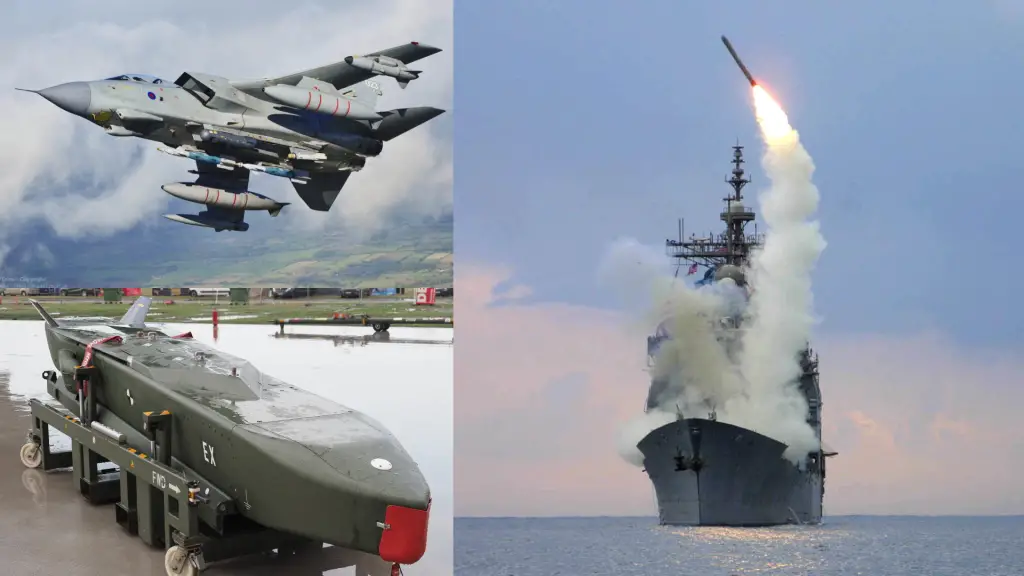The cruise missile, a formidable product of centuries of military ingenuity, has evolved from basic firework-like rockets to highly sophisticated weapons of precision. The journey began over 800 years ago in China, reaching a significant milestone with the development of the V-1 Flying Bomb during World War II. Today, these missiles are equipped with sophisticated guidance and propulsion systems, capable of striking targets across continents with chilling precision.
In the sections that follow, we’ll dissect the mechanics of cruise missiles and spotlight some of the most advanced models currently in use.
Anatomy of a cruise missile
Cruise missiles are unmanned, self-propelled vehicles designed for precision targeting of enemy installations and strategic assets. They are capable of sustained flight through aerodynamic lift and can be launched from various platforms including ground vehicles, aircraft, ships, and submarines. This versatility allows for strategic deployment across multiple domains of warfare.
Here are the key components that help a cruise missile deliver a payload to its target, including cutting-edge propulsion mechanisms and precision guidance systems.
Propulsion systems
The propulsion of a cruise missile is twofold. Initially, a rocket booster propels the missile to a necessary speed and altitude. After this boost phase, the booster is discarded, and a cruise engine, typically a turbojet or turbofan, takes over.
Turbojets are chosen for supersonic missiles needing high speeds, while turbofans are used for subsonic variants prioritizing fuel efficiency and stealth.
Flight control systems
Cruise missiles employ sophisticated flight control systems composed of aerodynamic surfaces such as wings, tail fins, and canards. These components are adjusted dynamically by onboard actuators, responding to the missile’s guidance system to maintain stability and control.
The design allows for low-altitude flight to evade radar, or higher altitudes to optimize fuel efficiency and evade defensive measures.
Guidance systems
Advanced guidance systems achieve accuracy in cruise missiles. Initial guidance often uses inertial methods, where the missile follows a predetermined path. Modern enhancements include terrain contour matching and satellite navigation via GPS or GLONASS for improved route accuracy.
In the terminal phase, missiles might use laser, radar, or infrared guidance, as well as Digital Scene Matching Area Correlation (DSMAC) to strike targets with high precision.
Modern cruise missiles and their strategic roles
In global defense, modern cruise missiles are unmatched in their ability to strike distant targets with sharp precision. This section highlights the strategic applications and technical specifications of modern cruise missiles, focusing on key models like the U.S. Tomahawk Land Attack Missile (TLAM) and the European Storm Shadow.
U.S. Tomahawk Land Attack Missile (TLAM)
Widely used in the Gulf War, Iraq War, and intervention in Libya, the TLAM is an essential component of U.S. military capabilities. Measuring 20.3 feet in length with an 8 feet 6 inches wingspan, it weighs 3,330 pounds, including a rocket motor. The Tomahawk operates with a Williams International F107 cruise turbo-fan engine and an ARC/CSD solid-fuel booster, achieving high subsonic speeds (Mach .5 to .75) and a range of 1,500 nautical miles for nuclear versions and 700 for conventional.
It uses various guidance systems to deliver payloads with an accuracy of about 5 meters. Launched from surface ships equipped with the MK41 Vertical Launch System (VLS), it can carry nuclear or conventional warheads, including the 1,000-pound BLU-97/B Combined Effects Bomb.
AGM-86B Maverick and AGM-129A Advanced Cruise Missile
The AGM-86B, operational since December 1982, is launched from B-52 aircraft, featuring a Litton inertial navigation system with terrain contour-matching updates. It spans 20 ft 10 in length and 12 ft in wingspan when extended, cruising subsonically at 550 mph over 1,500 nautical miles.
This nuclear-capable missile’s design helps evade radar detection. Conversely, the AGM-129A, designed exclusively for the B-52H, enhances stealth with a Williams International F-112-WR-100 turbofan engine, covering over 2,000 nautical miles at 500 mph. It integrates Lidar and Terrain Contour Matching (TERCOM) for navigation, emphasizing advancements in stealth and range.
British-French Storm Shadow/SCALP EG
This joint venture results in a missile designed for deep penetration strikes on fortified structures. The Storm Shadow/SCALP EG, known for its BROACH warhead, is launched from various aircraft, including the Eurofighter and Rafale.
It travels 250-400 kilometers, propelled by a Microturbo TRI-60-30 engine, and navigates via inertial and GPS systems, ensuring precision strikes with a 990-pound warhead.
German-Swedish Taurus KEPD 350
Engineered by Taurus Systems GmbH, the Taurus KEPD 350 is optimized for stealth and deep penetration. It can strike targets over 500 kilometers away without exposing the launch aircraft to enemy defenses.
It measures 16.4 feet in length and reaches speeds up to Mach 0.95, powered by a turbofan engine. The missile features an innovative Low-Level Terrain Following Navigation system and carries a 1,100-pound tandem warhead for maximum effectiveness against hardened targets.
Cruise missiles have advanced from their early, simplistic designs to become imperative in military strategies. As we look to the future, advancements in hypersonic speeds and artificial intelligence promise to further enhance their capabilities.
These technologies will enable missiles to execute missions with even greater precision and minimal collateral damage, opening up new possibilities for their use in complex combat scenarios.


Leave a Comment